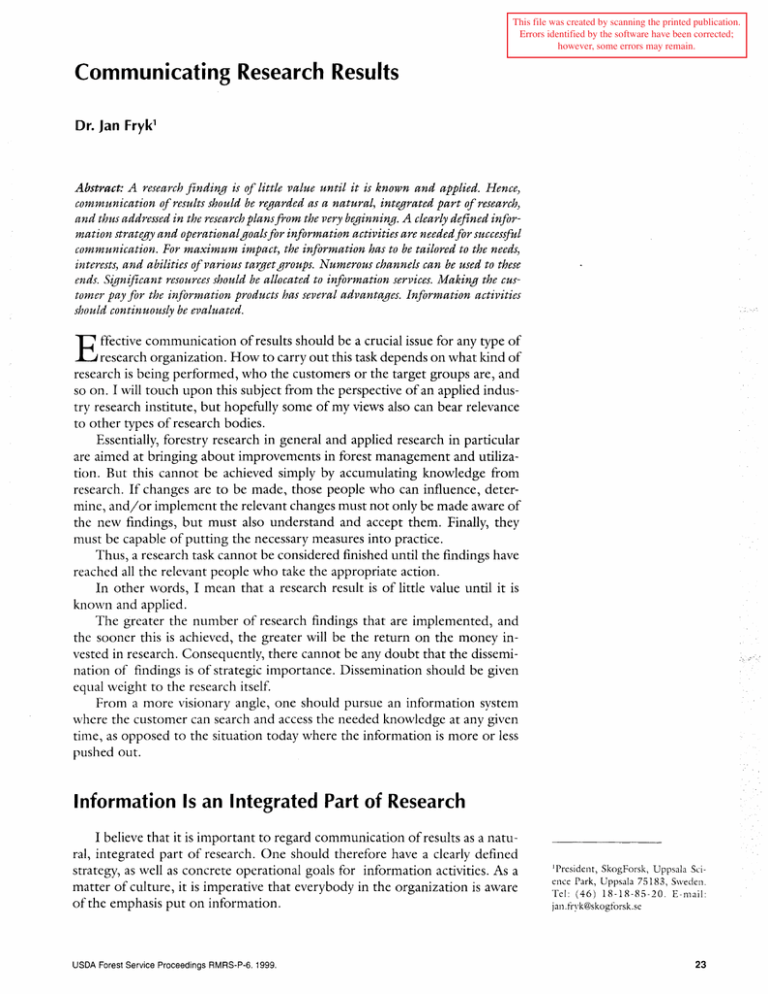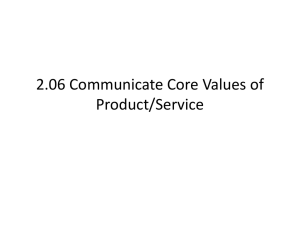Document 11871843
advertisement

This file was created by scanning the printed publication. Errors identified by the software have been corrected; however, some errors may remain. Communicating Research Results Dr. jan Fryk1 Abstract: A research finding is of little value until it is known and applied. Hence) communication of results should be regarded as a natural, integrated part of research) and thus addressed in the research plans from the very beginning. A clearly defined information strategy and operationalgoals for information activities are needed for successful communication. For maximum impact) the information has to be tailored to the needs) interests) and abilities of various tar;get groups. Numerous channels can be used to these ends. Significant resources should be allocated to information services. Making the customer pay for the information products has several advantages. Information activities should continuously be evaluated. E ffective communication of results should be a crucial issue for any type of research organization. How to carry out this task depends on what kind of research is being performed, who the customers or the target groups are, and so on. I will touch upon this subject from the perspective of an applied industry research institute, but hopefully some of my views also can bear relevance to other types of research bodies. Essentially, forestry research in general and applied research in particular are aimed at bringing about improvements in forest management and utilization. But this cannot be achieved simply by accumulating knowledge from research. If changes are to be made, those people who can influence, determine, and/or implement the relevant changes must not only be made aware of the new findings, but must also understand and accept them. Finally, they must be capable of putting the necessary measures into practice. Thus, a research task cannot be considered finished until the findings have reached all the relevant people who take the appropriate action. In other words, I mean that a research result is of little value until it is known and applied. The greater the number of research findings that are implemented, and the sooner this is achieved, the greater will be the return on the money invested in research. Consequently, there cannot be any doubt that the dissemination of findings is of strategic importance. Dissemination should be given equal weight to the research itself. From a more visionary angle, one should pursue an information system where the customer can search and access the needed knowledge at any given time, as opposed to the situation today where the information is more or less pushed out. Information Is an Integrated Part of Research I believe that it is important to regard communication of results as a natural, integrated part of research. One should therefore have a clearly defined strategy, as well as concrete operational goals for information activities. As a matter of culture, it is imperative that everybody in the organization is aware of the emphasis put on information. USDA Forest Service Proceedings RMRS-P-6. 1999. 1 President, SkogForsk, Uppsala Science Park, Uppsala 75183, Sweden. Tel: (46) 18-18-85-20. E-mail: jan.fryk@skogforsk.se 23 Communicating Research Results Fryk As part of the strategy, researchers/scientists should be made responsible, albeit with assistance, for communicating their findings to relevant receivers. They are the ones most knowledgeable in the matter at hand. Presenting one's own results also gives a very immediate feedback and evaluation of one's work. Accordingly, information ability and pedagogic skills ought to be considered when research staff is being recruited. Continuous competence development within this field should be facilitated and encouraged, and good performance should render merits. But even if the research staff have an individual responsibility to communicate their findings, it must be up to the organization to safeguard its external information functions according to the established strategy and overall goals, to ensure that quality standards are being met, and so on. It may then be a good idea to furnish the organization with professional staff that can act as support in information matters. Setting Goals and Analyzing Target Groups Successfully communicating results requires that information issues be addressed in the research plans from the very beginning. Right from the start one may ask the following questions: • What effects or changes do we want the research to bring about? • Which target groups need to share the findings so that desired changes can be implemented? • What knowledge will these people need to be given? • How shall this knowledge be passed on? The answer to these questions may very well affect the way in which the research is structured and carried through. For instance, it is important that material and data, which later might be needed in the communication process, are collected in the research work. The answer to the first question should really be the foundation for setting the goals for the entire project. These can then be broken down into individual objectives for research and for dissemination of its results. Target groups need to be carefully analyzed. Are we talking about other researchers, professional foresters, woodlot owners, forestry contractors, authorities, politicians, journalists, NGOs ... ? It goes without saying that the information cannot be presented in the same form to all these disparate categones. The information has to be adapted to the circumstances at hand and to the needs and interests of the respective group. For maximum impact, therefore, the same piece of information may often have to be produced in several different versions, so that it can be received and understood by all those one wants to reach. This may be a laborious and costly process but it is imperative. Numerous Channels There are numerous channels that can be used to communicate inform ation, each with its own merits and suitability. Publications tailored to various needs, in every form from scientific reports and textbooks to news leaflets and manuals, are of course still a very useful and effective avenue. Another channel 24 USDA Forest Service Proceedings RMRS-P-6. 1999. Communicating Research Results Fryk is courses, conferences, seminars, excursions, and field-days. Through mass media, i.e., articles in the press, radio and TV programs, a wide public can be reached. However, increasingly important and with a tremendous potential are the possibilities provided by modern IT media, such as direct-vision transmission, PC software programs, multimedia, and the Internet. Basically, I think that it is important that the research organization has a setup of its own controlled channels to major target groups and then use other channels creatively as complement. Each communication channel has its pros and cons. When deciding on a suitable channel, one has to start by determining which is the most suitable for the relevant subject and for the target group in question. Other more general criteria include the total production cost for the information, the cost per recipient, and the scope for adapting the information to different target groups. If the purpose is to pass on knowledge so that it can be applied in practice, we usually need to use more than one channel. For maximum impact, we should then use combinations of the methods and aids that are best suited to the relevant subject. A good way to start may be to follow the steps that we all take-consciously or subconsciously-when making any kind of decision: l. Awareness- I must know what options are available 2. Interest- I must find at least one of the options interesting 3. 4. Assessment - I assess the options on the basis of my experience Decision - I settle for one of the options 5. Implementation - I start to use the chosen option. A successful communication system must include all these steps and contain one or several information options for each. Allocate Resources But Make the Customer Pay Efficient communication of results is not for free. How it should be financed must be expressed in the information strategy. In my opinion, a quite substantial amount should be allocated to external communication. For an applied research institute, 15 percent of the total budget (outside of the primary documentation of findings) is not an unrealistic figure. As part of the strategy one may also state that information services should be self-financed to a certain extent, which means that the customers must pay for the products. Less money has to be derived from research funds, and the customers can demand quality, good accessibility and short lead-times. In turn, this puts pressure upon the research organization and provides incentives for its staff to live up to required standards and to keep the customer satisfied. The market forces also help to find the optimum level of the information output. Customer satisfaction is also an indicator of how successful one's external communication is. When, for instance, subscriptions are starting to drop, it is self-evident that an analysis needed and that measures probably have to be taken. Quality Requirements High quality in research, as well as in information, is essential. The information from a research-organization must be correct, comprehensive, and unbiUSDA Forest Service Proceedings RMRS-P-6. 1999. 25 Communicating Research Results Fryk ased. Regardless of form, it should also always be presented in ways that meet high quality standards. As mentioned earlier, the information has to be tailored to the various needs and abilities of different target groups. It should also be as current as possible. It may then be a good idea to set maximum lead times for producing the various information products. Follow-up and Evaluation Regardless of activity, I think that it is important to evaluate to what extent goals and objectives have been met as a part of an infinite process of continuous improvement. This is also applicable to research and research information, and likewise it is a classical dilemma. How, for instance, does one assess customer satisfaction and quantify the impact of one's research findings? However difficult, there are several tools for evaluating information activities. One important tool is a continuous dialogue and close contact with the customers through the daily research work. Formal channels like the board, advisory groups, and so on can also be used for feedback. Now and then, ad hoc external committees can be formed and engaged to evaluate research work as well as communication activities from various perspectives. Another rather useful tool is questionnaires directed to various target groups. Questionnaires can be oriented toward whatever aspects one wants to have elucidated, for instance, as a means to evaluate how information products are perceived. And of course, as regards to more purely scientific publications, referee and peer review systems are in themselves tools for evaluation. Conclusion In a research organization communication of results should be considered equally important and as a natural part of research itself. To enable efficient external information, a basic strategy is essential and significant recourses are needed. Further, as a vital part of such a strategy, one must realize that for maximum impact the information has to be adapted to various target groups. With acceptance for these views and by applying modern technology, the somewhat visionary concept of a system where the customer can access the needed knowledge at any given time is not too far away. 26 USDA Forest Service Proceedings RMRS-P-6. 1999.


